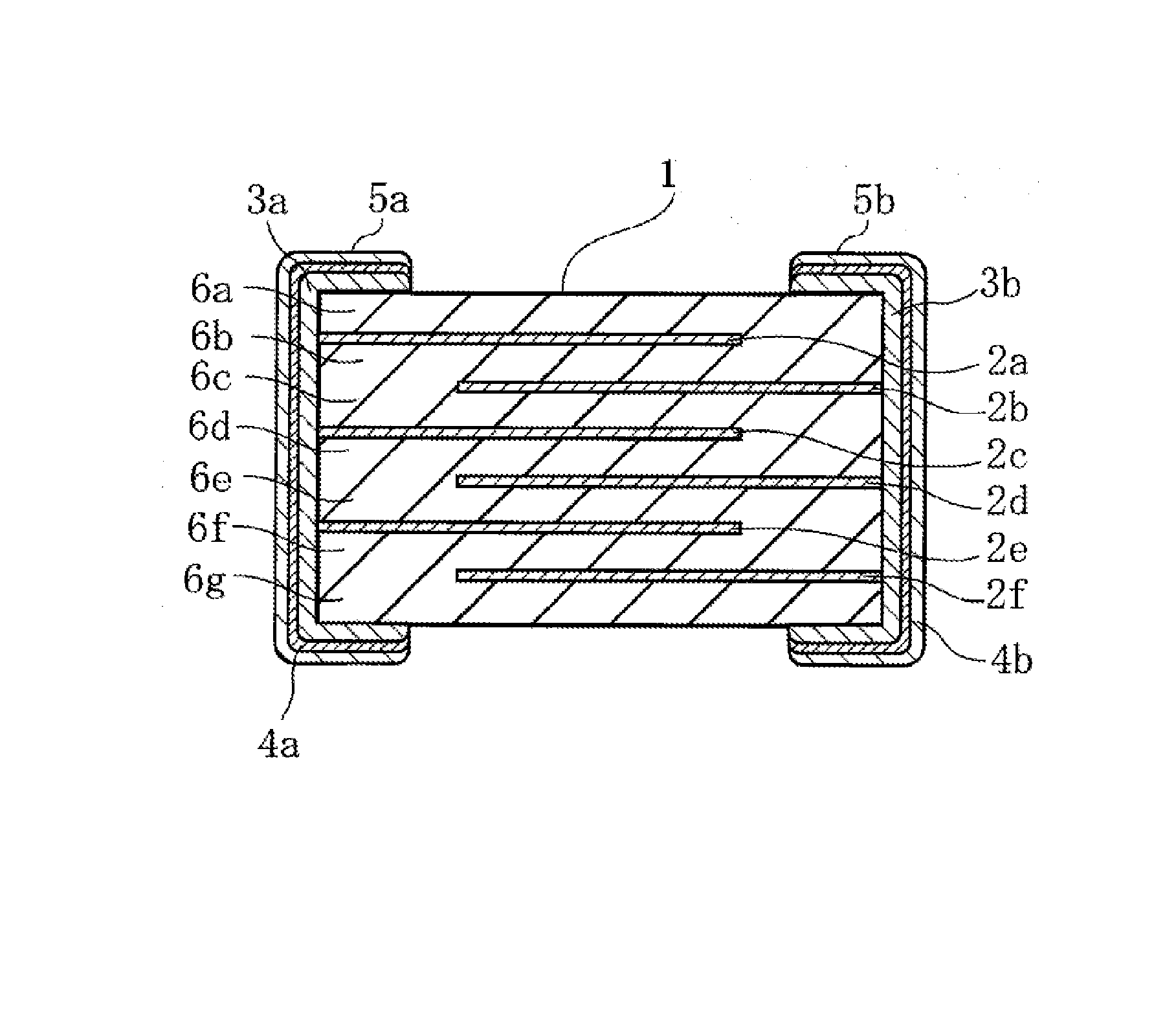Dielectric ceramic and laminated ceramic capacitor
a technology of laminated ceramic and dielectric ceramic, which is applied in the direction of fixed capacitor details, inorganic insulators, fixed capacitors, etc., can solve the problems of significant decrease in high-temperature load life, and achieve the effects of reducing high-temperature load life, and improving high-temperature load li
- Summary
- Abstract
- Description
- Claims
- Application Information
AI Technical Summary
Benefits of technology
Problems solved by technology
Method used
Image
Examples
example 1
[0074][Preparation of Samples]
[0075](Sample Numbers 1 to 6)
[0076]High-purity BaCO3, CaCO3, and TiO2 were prepared as ceramic raw materials, and these ceramic raw materials were weighed for the molar substitution x and compounding molar ratio m of Ca as shown in Table 1. Then, these weighed materials were put along with PSZ balls and pure water into a ball mill, subjected to sufficient mixing and grinding in a wet way, and to drying, and then subjected to calcination at a temperature of 1050° C. for about 2 hours, thereby preparing main constituent powders with an average grain size of 0.20 μm (synthesis of main-phase grains).
[0077]Next, Y2O3, SiO2, MgO, MnCO3, and V2O5 were prepared as accessory constituent powders. Then, these accessory constituent powders were weighed for the contents of Y, Si, Mg, Mn, and V in terms of parts by mol as shown in Table 1 with respect to 100 parts by mol of the Ti contained in the main constituent powder, and subjected to wet mixing in a ball mill, a...
example 2
[0120]High-purity BaCO3, CaCO3, and TiO2 were prepared as ceramic raw materials, and these ceramic raw materials were weighed for the molar substitution x and compounding molar ratio m of Ca as shown in Table 3. Then, these weighed materials were put along with PSZ balls and pure water into a ball mill, subjected to sufficient mixing and grinding in a wet way, and to drying, and then subjected to calcination at a temperature of 1000 to 1200° C. for about 2 hours, thereby preparing main constituent powders with an average grain size of 0.20 μm (synthesis of main-phase grains).
[0121]Next, Y2O3, SiO2, MgO, MnCO3, and V2O5 were prepared as accessory constituent powders. Then, these accessory constituent powders were weighed for the contents of Y, Si, Mg, Mn, and V in terms of parts by mol as shown in Table 3 with respect to 100 parts by mol of the Ti contained in the main-phase grains, and subjected to wet mixing in a ball mill, and to a drying treatment to obtain ceramic raw material p...
example 3
[0139]High-purity BaCO3, CaCO3, and TiO2 were prepared as ceramic raw materials, and these ceramic raw materials were weighed for the molar substitution x and compounding molar ratio m of Ca as shown in Table 4. Then, these weighed materials were put along with PSZ balls and pure water into a ball mill, subjected to sufficient mixing and grinding in a wet way, and to drying, and then subjected to calcination at a temperature of 1000 to 1200° C. for about 2 hours, thereby preparing main constituent powders with an average grain size of 0.20 μm.
[0140]Next, a rare-earth oxide Re2O2 (Re: Gd, Tb, Dy, Ho, Er, Tm, and Yb) was prepared, and SiO2, MgO, MnCO3, and V2O5 were further prepared. Then, these materials were weighed for the contents of the rare-earth element Re, Si, Mg, Mn, and V in terms of parts by mol as shown in Table 4 with respect to 100 parts by mol of the Ti in the main constituent powder, and subjected to wet mixing in a ball mill, and to a drying treatment to obtain cerami...
PUM
| Property | Measurement | Unit |
|---|---|---|
| Fraction | aaaaa | aaaaa |
| Thickness | aaaaa | aaaaa |
| Percent by mole | aaaaa | aaaaa |
Abstract
Description
Claims
Application Information
 Login to View More
Login to View More - R&D
- Intellectual Property
- Life Sciences
- Materials
- Tech Scout
- Unparalleled Data Quality
- Higher Quality Content
- 60% Fewer Hallucinations
Browse by: Latest US Patents, China's latest patents, Technical Efficacy Thesaurus, Application Domain, Technology Topic, Popular Technical Reports.
© 2025 PatSnap. All rights reserved.Legal|Privacy policy|Modern Slavery Act Transparency Statement|Sitemap|About US| Contact US: help@patsnap.com


